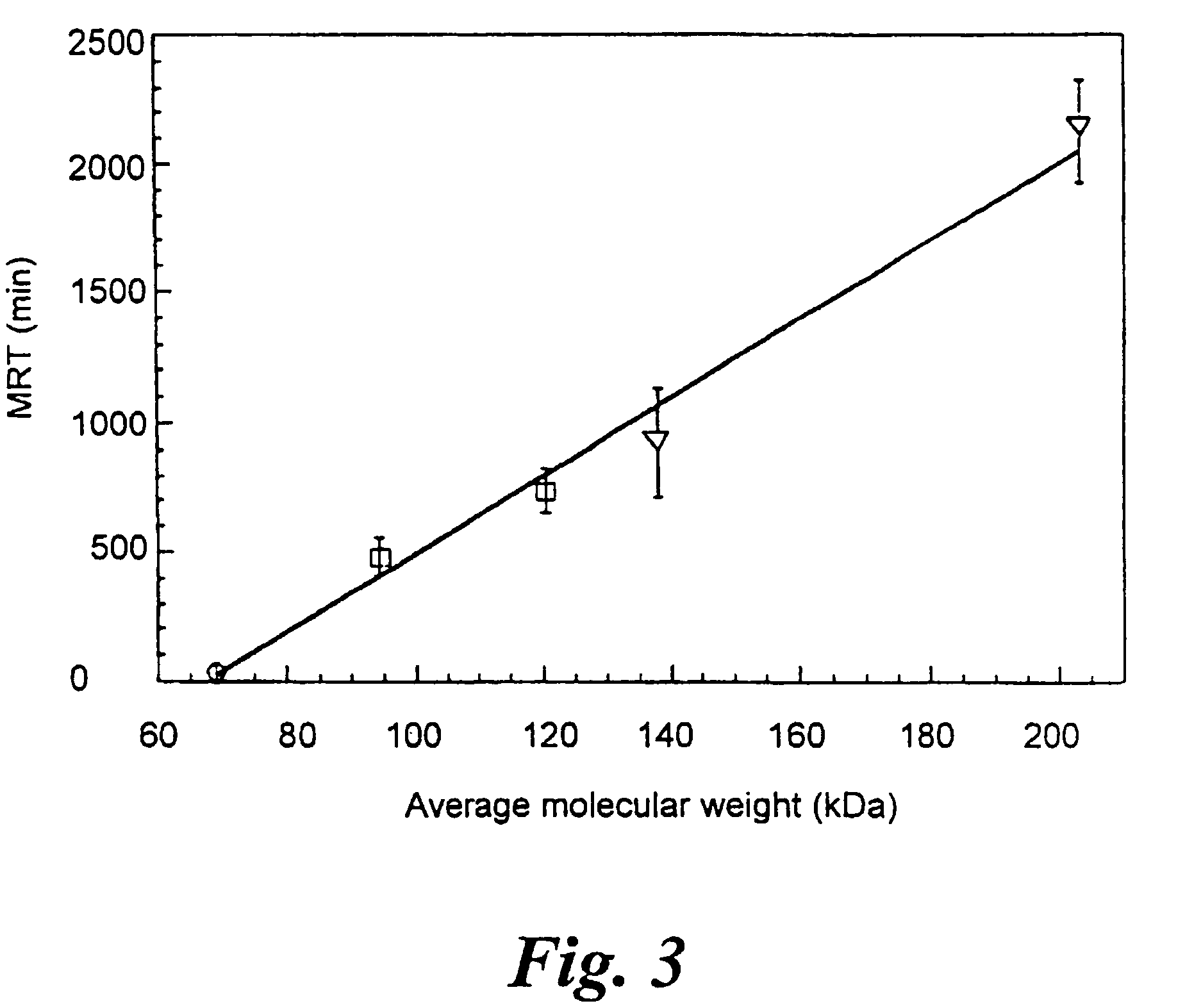Uses of chemically-modified cholinesterases for detoxification of organophosphorous compounds
a cholinesterase and chemical modification technology, applied in the field of chemical modification of cholinesterases, can solve the problems of reducing or losing biological activity, affecting affecting the conversion rate of cholinesterases, so as to improve the bioscavenging potential of enzymes, improve the bioscavenging potential, and improve the effect of catalytic performan
- Summary
- Abstract
- Description
- Claims
- Application Information
AI Technical Summary
Benefits of technology
Problems solved by technology
Method used
Image
Examples
example 1
Preparation of Recombinant Human AChE
[0046]A C-terminal truncated version of recombinant human AChE was prepared, to be used for conjugation. Truncation of the C-terminus (a substitution of the last 40 amino acids with a pentapeptide, ASEAP) of the T-subunit of human AChE [Soreq, H., et al. (1990), Proc. Natl. Acad. Sci. USA 87, 9688-9692; accession number for human AChE M55040], was preformed by DNA cassette replacement [Shafferman, A., et al., (1992), J. Biol. Chem. 267, 17640-17648], as described recently [Kryger, G., et al. (2000), Act. Cryst. D56, 1385-1394]. The DNA coding sequences for the truncated HuAChE (ΔC-HuAChE) was inserted into a tripartite expression vector expressing also the reporter gene cat and the selection marker neo [Velan, B., et al. (1991), J. Biol. Chem. 266, 23977-23984; Kronman, C., et al. (1992), Gene 121, 295-304]. Generation of stably transfected HEK-293 cell lines expressing high levels of rHuAChE and purification of the secreted enzyme was performed ...
example 2
[0047]Attachment of PEG chains to primary amines in rHuAChE was performed using succinimidyl propionate activated methoxy PEG (SPA-PEG; Shearwater polymers, Inc.). Purified ΔC-HuAChE resulting from example 1 (1-5 μM) was incubated with PEG-5000 or PEG-20000 in 50 mM phosphate buffer pH 8.0 for 2 hours at room temperature. PEG was added at a ratio of 5:1(low ratio) or 25:1 (high ratio) [PEG]0 / [AChE primary amines]0. The modified products were dialyzed extensively against phosphate buffer saline (PBS). Samples of the proteins were resolved on 7.5% SDS-polyacrylamide gels, electrotransfered onto nitrocellulose and subjected to Western-blot analysis using mouse polyclonal anti-HuAChE antibodies [Shafferman, A. et al., ibid].
[0048]The results of the SDS-PAGE analysis are set forth in FIG. 1 which shows the unique migration pattern of discrete bands of the PEG-AChE products generated under the various conditions. It is clear from these results that increasing the PEG to AChE ratio leads t...
example 3
[0049]Measurement of the kinetic parameters, as well as inhibition constants of non-modified and PEG-modified AChE demonstrated that, enzymatic performance of AChE was not affected by PEG-conjugation. This is surprising since, for many proteins, PEG conjugation leads to a reduction or loss of their biological activity [Monfardini, C. and Veronese, F. M. (1998), Bioconjug. Chem. 9, 418-450; Francis, G. E., et al. (1998), Inter. J. Hemato. 68, 1-18].
[0050]AChE activity was measured according to Ellman et al. [Ellman, G. L., et al. (1961), Biochem. Pharmacol. 7, 88-95]. Assays were performed in the presence of 0.5 mM acetylthiocholine, 50 mM sodium phosphate buffer pH 8.0, 0.1 mg / ml BSA and 0.3 mM 5,5′-dithiobis-(2-nitrobenzoic acid). The assay was carried out at 27° C. and monitored by a Thermomax microplate reader (Molecular Devices). Km values of HuAChE and PEG-HuAChE for acetylthiocholine were obtained from Lineweaver-Burk plots and kcat calculations were based on active-site titra...
PUM
| Property | Measurement | Unit |
|---|---|---|
| molecular weight | aaaaa | aaaaa |
| mean residence-time | aaaaa | aaaaa |
| molecular weight | aaaaa | aaaaa |
Abstract
Description
Claims
Application Information
 Login to View More
Login to View More - R&D
- Intellectual Property
- Life Sciences
- Materials
- Tech Scout
- Unparalleled Data Quality
- Higher Quality Content
- 60% Fewer Hallucinations
Browse by: Latest US Patents, China's latest patents, Technical Efficacy Thesaurus, Application Domain, Technology Topic, Popular Technical Reports.
© 2025 PatSnap. All rights reserved.Legal|Privacy policy|Modern Slavery Act Transparency Statement|Sitemap|About US| Contact US: help@patsnap.com



